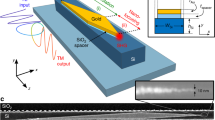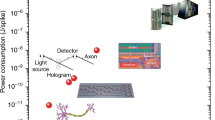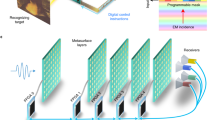Abstract
A range of alternative approaches to traditional digital hardware have been explored for the implementation of artificial neural networks, including optical neural networks and diffractive deep neural networks. Spoof surface plasmon polariton waveguides, which operate at microwave and terahertz frequencies, can offer low crosstalk, low radiation loss and easy integration, and are of potential use in the development of an alternative technology for artificial neural networks. Here, we report a programmable surface plasmonic neural network that is based on a spoof surface plasmon polariton platform and can detect and process microwaves. The approach uses a parallel coupled spoof surface plasmon polariton cell integrated with varactors. The weight coefficients of the cell can be adjusted by tuning the voltages of the varactors, and the activation function of the neural network can be programmed by detecting the input intensity and feeding back the threshold to an amplifier. We show that a two-layer fully connected surface plasmonic neural network consisting of four input cells and four output cells can perform a vector classification task. The surface plasmonic neural network can also be used to create a wireless communication system to decode and recover images. In addition, we show that partially connected surface plasmonic neural networks can classify handwritten digits with high accuracy.
This is a preview of subscription content, access via your institution
Access options
Access Nature and 54 other Nature Portfolio journals
Get Nature+, our best-value online-access subscription
$29.99 / 30 days
cancel any time
Subscribe to this journal
Receive 12 digital issues and online access to articles
$119.00 per year
only $9.92 per issue
Buy this article
- Purchase on Springer Link
- Instant access to full article PDF
Prices may be subject to local taxes which are calculated during checkout






Similar content being viewed by others
Data availability
The data that support the findings of this study are available from the corresponding authors upon reasonable request.
Code availability
The codes that support the theoretical modelling of the spoof plasmonic neural network are available from the corresponding authors upon reasonable request.
References
Shen, Y. et al. Deep learning with coherent nanophotonic circuits. Nat. Photon. 11, 441–446 (2017).
Krogh, A. What are artificial neural networks? Nat. Biotechnol. 26, 195–197 (2008).
Huang, H. M., Wang, Z., Wang, T., Xiao, Y. & Guo, X. Artificial neural networks based on memristive devices: from device to system. Adv. Intell. Syst. 2, 2000149 (2020).
Strukov, D. B. Smart connections. Nature 476, 403–405 (2011).
Tompson, J., Jain, A., LeCun, Y. & Bregler, C. Joint training of a convolutional network and a graphical model for human pose estimation. Adv. Neural Inf. Process. Syst. 2, 1799–1807 (2014).
Graves, A., Mohamed, A. & Hinton, G. Speech recognition with deep recurrent neural networks. In Proc. 2013 IEEE International Conference on Acoustics, Speech and Signal Processing 6646–6649 (IEEE, 2013).
Young, T., Hazarika, D., Poria, S. & Cambria, E. Recent trends in deep learning based natural language processing. IEEE Comput. Intell. Mag. 13, 55–75 (2018).
Xie, J., Xu, L. & Chen, E. Image denoising and inpainting with deep neural networks. Adv. Neural Inf. Process. Syst. 1, 341–349 (2012).
Gilmer, J., Schoenholz, S. S., Riley, P. F., Vinyals, O. & Dahl, G. E. Neural message passing for quantum chemistry. In Proc. 34th International Conference on Machine Learning, 70 (eds Precup, D. & Teh, Y. W.), 1263–1272 (PMLR, 2017).
Anthimopoulos, M., Christodoulidis, S., Ebner, L., Christe, A. & Mougiakakou, S. Lung pattern classification for interstitial lung diseases using a deep convolutional neural network. IEEE Trans. Med. Imaging 35, 1207–1216 (2016).
Lin, X. et al. All-optical machine learning using diffractive deep neural networks. Science 361, 1004–1008 (2008).
Krizhevsky, A., Sutskever, I. & Hinton, G. E. ImageNet classification with deep convolutional neural networks. Commun. Assoc. Comput. Mach. 60, 84–90 (2017).
He, K., Zhang, X., Ren, S. & Sun, J. Deep residual learning for image recognition. In Proc. Conference on Computer Vision and Pattern Recognition 770–778 (IEEE, 2016).
Yao, P. et al. Fully hardware-implemented memristor convolutional neural network. Nature 577, 641–647 (2020).
Harris, N. C. et al. Quantum transport simulations in a programmable nanophotonic processor. Nat. Photon. 11, 447–453 (2017).
Wetzstein, G. et al. Inference in artificial intelligence with deep optics and photonics. Nature 588, 39–47 (2020).
Zhuang, L., Roeloffzen, C. G. H., Hoekman, M., Boller, K.-J. & Lowery, A. J. Programmable photonic signal processor chip for radiofrequency applications. Optica 2, 854–859 (2015).
Zhang, Q., Yu, H., Barbiero, M., Wang, B. & Gu, M. Artificial neural networks enabled by nanophotonics. Light Sci. Appl. 8, 42–56 (2019).
Feldmann, J., Youngblood, N., Wright, C. D., Bhaskaran, H. & Pernice, W. H. All-optical spiking neurosynaptic networks with self-learning capabilities. Nature 569, 208–214 (2019).
Bogaerts, W. et al. Programmable photonic circuits. Nature 586, 207–216 (2020).
Wang, J., Sciarrino, F., Laing, A. & Thompson, M. G. Integrated photonic quantum technologies. Nat. Photon. 14, 273–284 (2020).
Wu, H. & Dai, Q. Artificial intelligence accelerated by light. Nature 589, 25–26 (2021).
Feldman, J. et al. Parallel convolutional processing using an integrated photonic tensor core. Nature 589, 52–58 (2021).
Zhou, T. et al. Large-scale neuromorphic optoelectronic computing with a reconfigurable diffractive processing unit. Nat. Photon. 15, 367–373 (2021).
Liu, C. et al. A programmable diffractive deep neural network based on a digital-coding metasurface array. Nat. Electron. 2, 113–122 (2022).
Williamson, I. A. D. et al. Reprogrammable electro-optic nonlinear activation functions for optical neural networks. IEEE J. Quantum Electron. 26, 7700412 (2020).
Joy, S. R., Erementchouk, M., Yu, H. & Mazumder, P. Spoof plasmon interconnects—communications beyond RC limit. IEEE Trans. Commun. 67, 599–610 (2019).
Pendry, J. B., Martin-Moreno, L. & Garcia-Vidal, F. J. Mimicking surface plasmons with structured surfaces. Science 305, 847–848 (2004).
Maier, S. A. Plasmonics: Fundamentals and Applications (Springer, 2007).
Shen, X., Cui, T. J., Martin-Cano, D. & Garcia-Vidal, F. J. Conformal surface plasmons propagating on ultrathin and flexible films. Proc. Natl Acad. Sci. USA 110, 40–45 (2013).
Zhang, H. C. et al. A plasmonic route for the integrated wireless communication of subdiffraction-limited signals. Light Sci. Appl. 9, 113 (2020).
Gao, X. et al. Crosstalk suppression based on mode mismatch between spoof SPP transmission line and microstrip. IEEE Trans. Compon. Package Manuf. Technol. 9, 2267–2275 (2019).
Zhang, H. C., Cui, T. J., Zhang, Q., Fan, Y. & Fu, X. Breaking the challenge of signal integrity using time-domain spoof surface plasmon polaritons. ACS Photon. 2, 1333–1340 (2015).
Cui, T. J. Microwave metamaterials. Nat. Sci. Rev. 5, 134–136 (2018).
Gao, X. et al. Programmable multifunctional device based on spoof surface plasmon polaritons. IEEE Trans. Antennas Propag. 68, 1558 (2020).
Gao, X. et al. Programmable hybrid circuit based on reconfigurable SPP and spatial waveguide modes. Adv. Mater. Technol. 5, 1900828 (2019).
Zhang, J. et al. Integrated spoof plasmonic circuits. Sci. Bull. 64, 843–855 (2019).
Ma, Q. et al. Controllable and programmable nonreciprocity based on detachable digital coding metasurface. Adv. Opt. Mater. 7, 1901285 (2019).
Ma, Q. et al. Smart sensing metasurface with self-defined functions in dual polarization. Nanophotonics 9, 3271–3278 (2020).
IEEE Standard for Information Technology—Telecommunications and Information Exchange Between Systems—Local and Metropolitan Area Networks—Specific Requirements—Part 11: Wireless LAN Medium Access Control (MAC) and Physical Layer (PHY) Specifications—Amendment 4: Enhancements for Very High Throughput for Operation in Bands Below 6 GHz IEEE Std 802.11ac-2013 (amendment to IEEE Std 802.11-2012, as amended by IEEE Std 802.11ae-2012, IEEE Std 802.11aa-2012, and IEEE Std 802.11ad-2012) (IEEE, 2013).
Acknowledgements
This work was supported by the Basic Scientific Center of Information Metamaterials of the National Natural Science Foundation of China under grants 62288101 (T.J.C.) and 92167202 (Q.M.), the National Key Research and Development Program of China under grants 2017YFA0700201, 2017YFA0700202 and 2017YFA0700203 (T.J.C.), the Major Project of Natural Science Foundation of Jiangsu Province under grant BK20212002 (T.J.C.), the 111 Project under grant 111-2-05 (T.J.C.) and the China Postdoctoral Science Foundation under grants 2021M700761 and 2022T150112 (Q.M.).
Author information
Authors and Affiliations
Contributions
T.J.C. and Q.M. initiated the plan and supervised the entire study. X.G., Q.M. and Z.G. conceived the idea of this work, and designed the simulations and experiments. X.G., Q.M., Z.G., W.Y.C., J.Z. and C.L. carried out the measurements and data analyses. X.G., Q.M., Z.G. and T.J.C. prepared the manuscript with input from all authors. All authors discussed the research.
Corresponding authors
Ethics declarations
Competing interests
The authors declare no competing interests.
Peer review
Peer review information
Nature Electronics thanks the anonymous reviewers for their contribution to the peer review of this work.
Additional information
Publisher’s note Springer Nature remains neutral with regard to jurisdictional claims in published maps and institutional affiliations.
Supplementary information
Supplementary information
Supplementary Sections 1–18, Figs. 1–16 and Tables 1–10.
Rights and permissions
Springer Nature or its licensor (e.g. a society or other partner) holds exclusive rights to this article under a publishing agreement with the author(s) or other rightsholder(s); author self-archiving of the accepted manuscript version of this article is solely governed by the terms of such publishing agreement and applicable law.
About this article
Cite this article
Gao, X., Ma, Q., Gu, Z. et al. Programmable surface plasmonic neural networks for microwave detection and processing. Nat Electron 6, 319–328 (2023). https://doi.org/10.1038/s41928-023-00951-x
Received:
Accepted:
Published:
Issue Date:
DOI: https://doi.org/10.1038/s41928-023-00951-x
This article is cited by
-
Light-sensing metasurface with flexible reprogrammable functions
Applied Physics A (2023)



